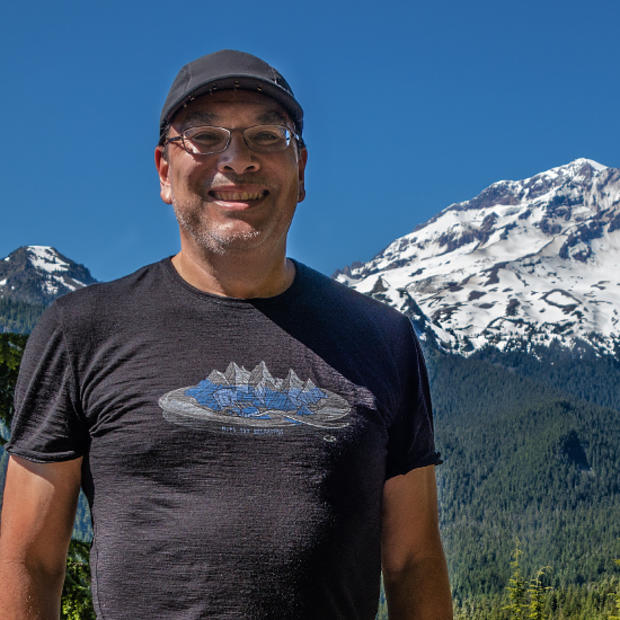“I’m not a liberal,” the woman warns. She is white.
“We need you,” Batayola implores. Beacon Hill is about 80 percent nonwhite, although that doesn’t account for recent gentrification, which is focused on the north end.
As Batayola knows, Beacon Hill needs more than this would-be volunteer or anyone else it can quickly muster. It particularly needs a gas mask and industrial ear plugs. It is one of the most polluted neighborhoods in Seattle, and the place is being assaulted by noise and carbon waste from every angle imaginable, even overhead.
The carrot-shaped neighborhood is ringed by Interstate 5, Boeing Field and the SoDo industrial district on the west, I-90 on the north, and Martin Luther King Jr. Way and the Link light rail line on the east. The tapered south end of Beacon Hill points like the ominous skeletal finger of the ghost of Christmas yet-to-come toward Seattle-Tacoma International Airport, for which it serves as a kind of extended runway.
My parents have lived for more than 50 years on Beacon Hill, which is where I grew up. When I tell people that I graduated from Cleveland High School, they tend to say, “Oh, the school I can see from the freeway.” Whenever I visit, I cannot help noticing the racket of jetliners every two or three minutes. When that particular cacophony subsides, I can hear the roar of traffic coming off I-5. I once asked my father how he stands it.
“Stand what?” he asked.
Not everyone adjusts thusly. Startled one night by a passing jet, Batayola says, “It was so bad, I thought we were at war.”
Batayola is now – at war, that is. The environmental justice coordinator at El Centro de la Raza, she is engaged with a veritable alphabet soup of agencies, committees and other bodies at every level of government, federal and local, on a bewildering number of fronts.
Since Beacon Hill is so overwhelmingly nonwhite, race is, of course, a factor in all of this. In March, a study published in the journal PNAS found that air pollution is caused disproportionately by white American consumption of goods and services, but inhaled disproportionately by Black and Latinx people. Another study found that urban noise pollution is concentrated in low-income communities and communities of color. A mapping tool developed by the University of Washington’s Department of Environmental and Occupational Health Sciences shows that Beacon Hill and other South Seattle neighborhoods suffer among the highest levels of environmental health risks in the state.
The urgency of Beacon Hill’s environmental plight was heightened in 2012 when as part of a double-edged project called “Greener Skies over Seattle,” the Federal Aviation Administration approved an inbound flight path right over Beacon Hill. The adjustment lowered noise pollution in northern Seattle neighborhoods. Measurements crowdsourced from Cleveland High teachers and students found at the school an average noise pollution level of 81.6 dB, well above the FAA’s threshold of 65 dB and 26.6 dB higher than both Seattle’s daytime noise pollution standard and the World Health Organization’s guidelines for outdoor playgrounds.
Beacon Hill is not eligible for sound-mitigation funds through the FAA because it is not considered directly aviation-impacted. U.S. Rep. Adam Smith, whose district includes the neighborhood, has introduced legislation to address that.
The neighborhood was a little quieter and less hazy when Batayola moved there. She was 14 when she immigrated to Seattle with her family from Metro Manila in the Philippines. They originally lived in the Central Area, where she attended Immaculate Conception High School. But Batayola yearned to hear more languages and accents and live among more racial diversity, and she found all of that in Beacon Hill, where she lived for more than 30 years.
Even though marriage whisked her to Bellevue seven years ago, Batayola said her heart remained in her longtime neighborhood. There, she seems constantly on the stump, seeking support and participation.
“We’re fighting for the quality of our lives,” Batayola says. “In vulnerable neighborhoods, if you’re not complaining enough, [others believe] there’s no problem.”
Bayatola lately has upped the volume by figuratively shaking the dwindling canopy of Beacon Hill. In addition to their ability to lock up large amounts of carbon, trees also provide buffers against noise. Strengthening the Seattle Tree Ordinance would help at least partially because it might provide muscle as the neighborhood braces for upzoning development.
A 21-acre lot called the “Brick Pit” likely will serve as ground zero for a battle royale over development on Beacon Hill. The stretch of land at 4001 12th Ave. S. earned its moniker for once having housed two brick factories notable for helping rebuild Pioneer Square after the fire of 1889. It literally occupies a slippery slope down to I-5, containing three wetland sites and a large hunk of the neighborhood’s tree cover. It may be the largest undeveloped, privately owned and residentially zoned lot left in the city on which, according to plans and permit applications, developers seek to build 124 single-family housing units.
So numerous are the forces sucking the clarity from Beacon Hill, Batayola concedes that she often feels like “I am sticking as many fingers into as many holes in the dike that I can.” She sometimes believes the neighborhood needs to be fitted with some kind of bubble.
Yet asked if she is optimistic about the neighborhood’s future, Batayola says, “I’m alive. Sí, se puede.”
Clarification: An earlier version of this story and its headline referred to Beacon Hill as Seattle's most polluted neighborhood rather than one of the most polluted neighborhoods. There are various measures of pollution, making the designation debatable.


